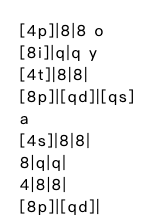Roblox Sheet

Roblox Sheet
Je te laisserai des mots
Patrick Watson
Je te laisserai des motsをPatrick Watsonによって新しい方法で体験しましょう!あなたのキーボードを使用して、Je te laisserai des mots Robloxピアノシートを仮想キーボードピアノで演奏します。Robloxピアノゲームのプレイヤーであっても、クラシックな曲を練習したい方でも、このJe te laisserai des mots Robloxピアノシートはあなたに最適です。初心者から上級者への進歩が簡単になります。Je te laisserai des motsはTOP 100 Robloxピアノシートに含まれており、他にも簡単な曲、クラシック、ポップ、クリスマスソング、ディズニーコレクションがあなたのためにあります!
49 ビュー
Roblox Sheet

Roblox Sheet
Je te laisserai des mots
Patrick Watson
Je te laisserai des motsをPatrick Watsonによって新しい方法で体験しましょう!あなたのキーボードを使用して、Je te laisserai des mots Robloxピアノシートを仮想キーボードピアノで演奏します。Robloxピアノゲームのプレイヤーであっても、クラシックな曲を練習したい方でも、このJe te laisserai des mots Robloxピアノシートはあなたに最適です。初心者から上級者への進歩が簡単になります。Je te laisserai des motsはTOP 100 Robloxピアノシートに含まれており、他にも簡単な曲、クラシック、ポップ、クリスマスソング、ディズニーコレクションがあなたのためにあります!
33 ビュー
Roblox Sheet

Roblox Sheet
Je te laisserai des mots
Patrick Watson
Je te laisserai des motsをPatrick Watsonによって新しい方法で体験しましょう!あなたのキーボードを使用して、Je te laisserai des mots Robloxピアノシートを仮想キーボードピアノで演奏します。Robloxピアノゲームのプレイヤーであっても、クラシックな曲を練習したい方でも、このJe te laisserai des mots Robloxピアノシートはあなたに最適です。初心者から上級者への進歩が簡単になります。Je te laisserai des motsはTOP 100 Robloxピアノシートに含まれており、他にも簡単な曲、クラシック、ポップ、クリスマスソング、ディズニーコレクションがあなたのためにあります!
29 ビュー
Roblox Sheet

Roblox Sheet
Je te laisserai des mots
Patrick Watson
Je te laisserai des motsをPatrick Watsonによって新しい方法で体験しましょう!あなたのキーボードを使用して、Je te laisserai des mots Robloxピアノシートを仮想キーボードピアノで演奏します。Robloxピアノゲームのプレイヤーであっても、クラシックな曲を練習したい方でも、このJe te laisserai des mots Robloxピアノシートはあなたに最適です。初心者から上級者への進歩が簡単になります。Je te laisserai des motsはTOP 100 Robloxピアノシートに含まれており、他にも簡単な曲、クラシック、ポップ、クリスマスソング、ディズニーコレクションがあなたのためにあります!
17 ビュー
Roblox Sheet

Roblox Sheet
Je te laisserai des mots x Where Is My Heart Emotional Mashup
Patrick Watson
Je te laisserai des mots x Where Is My Heart Emotional MashupをPatrick Watsonによって新しい方法で体験しましょう!あなたのキーボードを使用して、Je te laisserai des mots x Where Is My Heart Emotional Mashup Robloxピアノシートを仮想キーボードピアノで演奏します。Robloxピアノゲームのプレイヤーであっても、クラシックな曲を練習したい方でも、このJe te laisserai des mots x Where Is My Heart Emotional Mashup Robloxピアノシートはあなたに最適です。初心者から上級者への進歩が簡単になります。Je te laisserai des mots x Where Is My Heart Emotional MashupはTOP 100 Robloxピアノシートに含まれており、他にも簡単な曲、クラシック、ポップ、クリスマスソング、ディズニーコレクションがあなたのためにあります!
12 ビュー
Roblox Sheet

Roblox Sheet
Je te laisserai des mots
Patrick Watson
Je te laisserai des motsをPatrick Watsonによって新しい方法で体験しましょう!あなたのキーボードを使用して、Je te laisserai des mots Robloxピアノシートを仮想キーボードピアノで演奏します。Robloxピアノゲームのプレイヤーであっても、クラシックな曲を練習したい方でも、このJe te laisserai des mots Robloxピアノシートはあなたに最適です。初心者から上級者への進歩が簡単になります。Je te laisserai des motsはTOP 100 Robloxピアノシートに含まれており、他にも簡単な曲、クラシック、ポップ、クリスマスソング、ディズニーコレクションがあなたのためにあります!
11 ビュー
Roblox Sheet

Roblox Sheet
Je te laisserai des mots
Patrick Watson
Je te laisserai des motsをPatrick Watsonによって新しい方法で体験しましょう!あなたのキーボードを使用して、Je te laisserai des mots Robloxピアノシートを仮想キーボードピアノで演奏します。Robloxピアノゲームのプレイヤーであっても、クラシックな曲を練習したい方でも、このJe te laisserai des mots Robloxピアノシートはあなたに最適です。初心者から上級者への進歩が簡単になります。Je te laisserai des motsはTOP 100 Robloxピアノシートに含まれており、他にも簡単な曲、クラシック、ポップ、クリスマスソング、ディズニーコレクションがあなたのためにあります!
10 ビュー
Roblox Sheet

Roblox Sheet
Je te laisserai des mots
Patrick Watson
Je te laisserai des motsをPatrick Watsonによって新しい方法で体験しましょう!あなたのキーボードを使用して、Je te laisserai des mots Robloxピアノシートを仮想キーボードピアノで演奏します。Robloxピアノゲームのプレイヤーであっても、クラシックな曲を練習したい方でも、このJe te laisserai des mots Robloxピアノシートはあなたに最適です。初心者から上級者への進歩が簡単になります。Je te laisserai des motsはTOP 100 Robloxピアノシートに含まれており、他にも簡単な曲、クラシック、ポップ、クリスマスソング、ディズニーコレクションがあなたのためにあります!
10 ビュー
Roblox Sheet

Roblox Sheet
Je te laisserai des mots
Patrick Watson
Je te laisserai des motsをPatrick Watsonによって新しい方法で体験しましょう!あなたのキーボードを使用して、Je te laisserai des mots Robloxピアノシートを仮想キーボードピアノで演奏します。Robloxピアノゲームのプレイヤーであっても、クラシックな曲を練習したい方でも、このJe te laisserai des mots Robloxピアノシートはあなたに最適です。初心者から上級者への進歩が簡単になります。Je te laisserai des motsはTOP 100 Robloxピアノシートに含まれており、他にも簡単な曲、クラシック、ポップ、クリスマスソング、ディズニーコレクションがあなたのためにあります!
9 ビュー
Roblox Sheet

Roblox Sheet
Je te laisserai des mots
Patrick Watson
Je te laisserai des motsをPatrick Watsonによって新しい方法で体験しましょう!あなたのキーボードを使用して、Je te laisserai des mots Robloxピアノシートを仮想キーボードピアノで演奏します。Robloxピアノゲームのプレイヤーであっても、クラシックな曲を練習したい方でも、このJe te laisserai des mots Robloxピアノシートはあなたに最適です。初心者から上級者への進歩が簡単になります。Je te laisserai des motsはTOP 100 Robloxピアノシートに含まれており、他にも簡単な曲、クラシック、ポップ、クリスマスソング、ディズニーコレクションがあなたのためにあります!
9 ビュー
Roblox Sheet

Roblox Sheet
Je te laisserai des mots
Patrick Watson
Je te laisserai des motsをPatrick Watsonによって新しい方法で体験しましょう!あなたのキーボードを使用して、Je te laisserai des mots Robloxピアノシートを仮想キーボードピアノで演奏します。Robloxピアノゲームのプレイヤーであっても、クラシックな曲を練習したい方でも、このJe te laisserai des mots Robloxピアノシートはあなたに最適です。初心者から上級者への進歩が簡単になります。Je te laisserai des motsはTOP 100 Robloxピアノシートに含まれており、他にも簡単な曲、クラシック、ポップ、クリスマスソング、ディズニーコレクションがあなたのためにあります!
9 ビュー
Roblox Sheet

Roblox Sheet
Je te laisserai des mots
Patrick Watson
Je te laisserai des motsをPatrick Watsonによって新しい方法で体験しましょう!あなたのキーボードを使用して、Je te laisserai des mots Robloxピアノシートを仮想キーボードピアノで演奏します。Robloxピアノゲームのプレイヤーであっても、クラシックな曲を練習したい方でも、このJe te laisserai des mots Robloxピアノシートはあなたに最適です。初心者から上級者への進歩が簡単になります。Je te laisserai des motsはTOP 100 Robloxピアノシートに含まれており、他にも簡単な曲、クラシック、ポップ、クリスマスソング、ディズニーコレクションがあなたのためにあります!
8 ビュー
Roblox Sheet

Roblox Sheet
Je Te Laisserai Des Mots
Patrick Watson
Je Te Laisserai Des MotsをPatrick Watsonによって新しい方法で体験しましょう!あなたのキーボードを使用して、Je Te Laisserai Des Mots Robloxピアノシートを仮想キーボードピアノで演奏します。Robloxピアノゲームのプレイヤーであっても、クラシックな曲を練習したい方でも、このJe Te Laisserai Des Mots Robloxピアノシートはあなたに最適です。初心者から上級者への進歩が簡単になります。Je Te Laisserai Des MotsはTOP 100 Robloxピアノシートに含まれており、他にも簡単な曲、クラシック、ポップ、クリスマスソング、ディズニーコレクションがあなたのためにあります!
7 ビュー
Roblox Sheet

Roblox Sheet
Je te laisserai des mots
Patrick Watson
Je te laisserai des motsをPatrick Watsonによって新しい方法で体験しましょう!あなたのキーボードを使用して、Je te laisserai des mots Robloxピアノシートを仮想キーボードピアノで演奏します。Robloxピアノゲームのプレイヤーであっても、クラシックな曲を練習したい方でも、このJe te laisserai des mots Robloxピアノシートはあなたに最適です。初心者から上級者への進歩が簡単になります。Je te laisserai des motsはTOP 100 Robloxピアノシートに含まれており、他にも簡単な曲、クラシック、ポップ、クリスマスソング、ディズニーコレクションがあなたのためにあります!
7 ビュー
Roblox Sheet

Roblox Sheet
Je te laisserai des mots
Patrick Watson
Je te laisserai des motsをPatrick Watsonによって新しい方法で体験しましょう!あなたのキーボードを使用して、Je te laisserai des mots Robloxピアノシートを仮想キーボードピアノで演奏します。Robloxピアノゲームのプレイヤーであっても、クラシックな曲を練習したい方でも、このJe te laisserai des mots Robloxピアノシートはあなたに最適です。初心者から上級者への進歩が簡単になります。Je te laisserai des motsはTOP 100 Robloxピアノシートに含まれており、他にも簡単な曲、クラシック、ポップ、クリスマスソング、ディズニーコレクションがあなたのためにあります!
7 ビュー



















